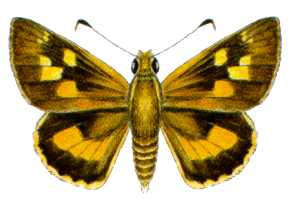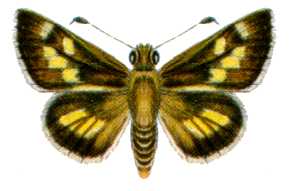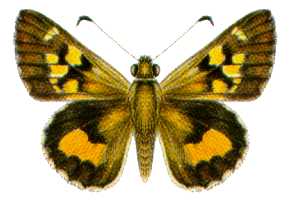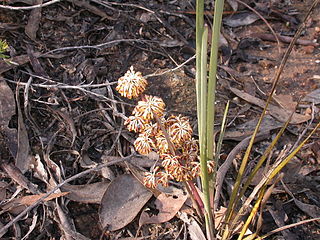
Trapezites eliena, commonly known as the orange ochre or eliena skipper, is a species of butterfly in the family Hesperiidae. It is endemic to Australia, where it occurs in Australian Capital Territory, New South Wales, Queensland, South Australia, and Victoria. It inhabits coastal or montane eucalypt forests.

Lomandra longifolia, commonly known as spiny-head mat-rush, spiky-headed mat-rush or basket grass, is a perennial, rhizomatous herb found throughout eastern Australia. The leaves are 40 cm to 80 cm long, and generally have a leaf of about 8 mm to 12 mm wide. It grows in a variety of soil types and is frost, heat and drought tolerant. Labillardiere described Lomandra longifolia from a specimen collected in Tasmania.

Trapezites heteromacula, the orange white-spot skipper, is a butterfly of the family Hesperiidae. It is found on Australia's Cape York.

Trapezites iacchus, the Iacchus skipper, is a butterfly of the family Hesperiidae. It is found in the Australian states of New South Wales and Queensland.

Trapezites luteus, the rare white spot skipper, is a butterfly of the family Hesperiidae. It is found in Australia in the states of New South Wales, Victoria, South Australia and Tasmania.

Trapezites petalia, the common white spot skipper or black-ringed ochre, is a butterfly of the family Hesperiidae. It is found in the Australian states of Queensland and New South Wales.

Trapezites phigalia, commonly known as the heath ochre or phigalia skipper, is a species of butterfly in the family Hesperiidae. It is endemic to Australia, where it occurs in New South Wales, Queensland, South Australia and Victoria. It is primarily found in eucalypt woodlands, open forests, and coastal healthland habitats.

Trapezites symmomus is a butterfly of the family Hesperiidae. It is found in Queensland, Victoria, South Australia and New South Wales.
Trapezites praxedes, commonly known as the southern silver ochre or praxedes skipper, is a species of butterfly in the family Hesperiidae. It is endemic to Australia, where it occurs in New South Wales, Queensland and Victoria.

Lomandra obliqua, known as fish bones and twisted mat-rush, is a small wiry ground covering plant found in eastern Australia. A widespread plant seen on the coast and tablelands. The foliage superficially resembles a fern, but creamy/yellow flowers form on clusters in spring. Leaves are two ranked, somewhat glaucous and twisted.

The Brush Island is a continental island, contained within the Brush Island Nature Reserve, a protected nature reserve, known as Mit Island in the Dhurga language of the Murramamrang people of the Yuin nation see It is located off the south coast of New South Wales, Australia. The 47-hectare (120-acre) island and reserve is situated within the Tasman Sea, approximately 2 kilometres (1.2 mi) south-east of the coastal village of Bawley Point.

Lomandra confertifolia is a species of perennial herbs in the genus Lomandra, Asparagaceae, subfamily Lomandroideae. It is native to Queensland, Australia. Although it appears grass-like, it is not in the grass family.

Lomandra gracilis is a perennial, rhizomatous herb found in New South Wales and Queensland in eastern Australia.

Lomandra filiformis, commonly known as wattle mat-rush, is a tussock forming perennial herb that is native to Australia. It is sparsely tufted, with strap-like leaves and yellow flowers. It grows in dry sclerophyll forest and grassy woodland, usually on well-drained rocky or sandy soils.

Lomandra spicata is a rainforest plant found in eastern Australia.
Lomandra montana is a perennial, rhizomatous herb found in eastern Australia.

Lomandra multiflora is a perennial, rhizomatous herb found in Australia. Lomandra multiflora is also commonly known as many-flowered mat rush, mat rush and many flowered mat-lily. Lomandra multiflora is a species that is native to Australia and can be found in New South Wales, Queensland, Victoria, South Australia, Northern Territory of Australia and also in Papua New Guinea. The mat rush is distributed widely in the region and common within its preferred growing conditions. The conservation status of Lomandra multiflora is considered not to be of concern and risk.

Brenan Park is a 20-hectare (49-acre) urban park situated in the western suburbs of Sydney, New South Wales, Australia. Primarily categorised as a sports field, the reserve contains an open grassland, bushland and recreational areas within the vicinity of native plants, such as eucalyptus trees. It is named after John Ryan Brenan, who founded the suburb of Smithfield in 1836.

The Eastern Suburbs Banksia Scrub, which also incorporates Sydney Coastal Heaths, is a remnant sclerophyll scrubland and heathland that is found in the eastern and southern regions of Sydney, New South Wales, Australia. Listed under the Environment Protection and Biodiversity Conservation Act 1999 as and endangered vegetation community and as 'critically endangered' under the NSW Biodiversity Conservation Act 2016, the Eastern Suburbs Banksia Scrub is found on ancient, nutrient poor sands either on dunes or on promontories. Sydney coastal heaths are a scrubby heathland found on exposed coastal sandstone plateau in the south.

Coastal Swamp Oak Forests, also known as Swamp Oak Floodplain Forests and Estuarine swamp oak forests, are scattered riparian forests found in southeastern Queensland to southeastern New South Wales, Australia that would predominantly feature Casuarina glauca. They occur within the South Eastern Queensland, NSW North Coast, Sydney Basin, or South East Corner bioregions.

















